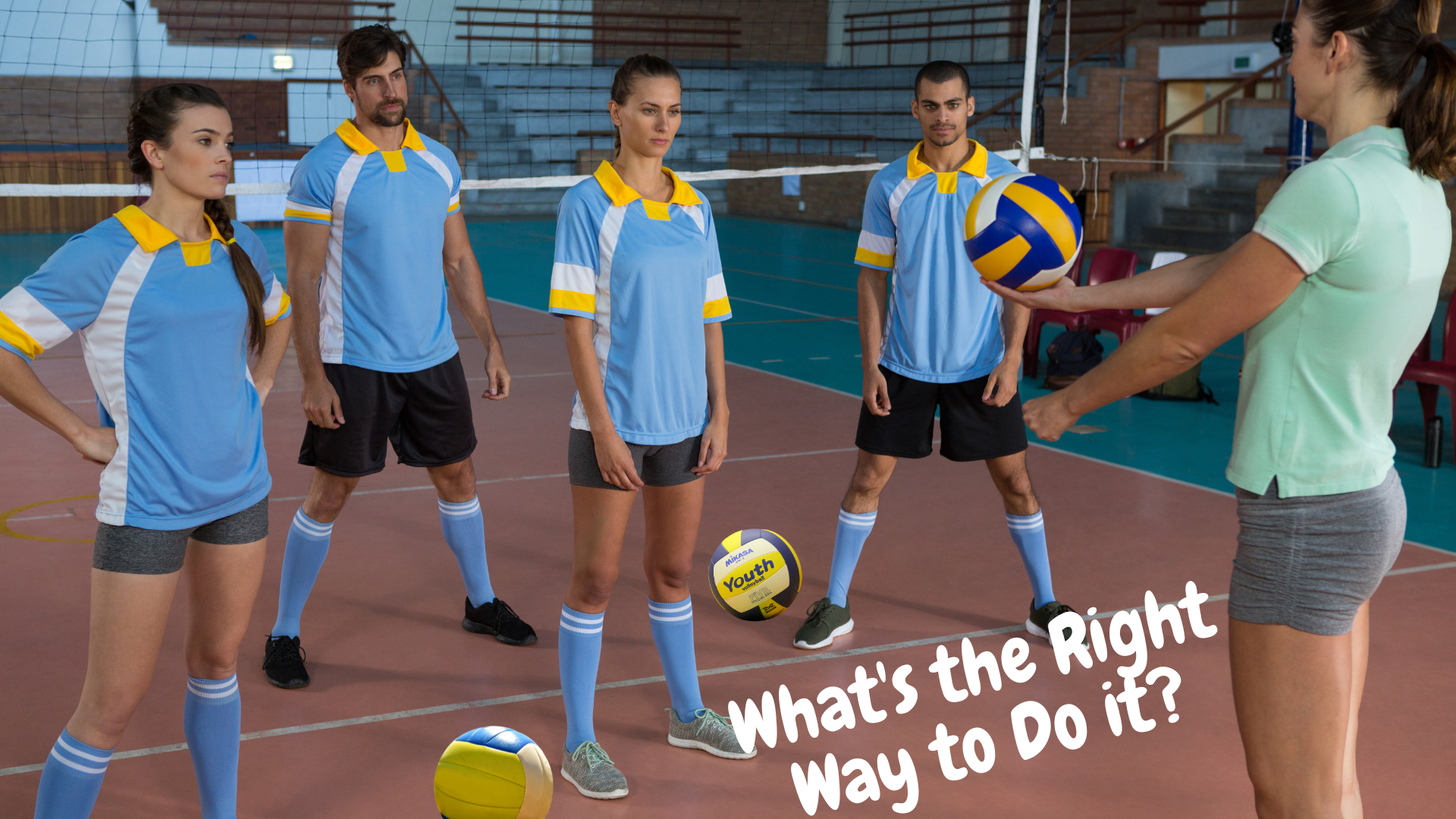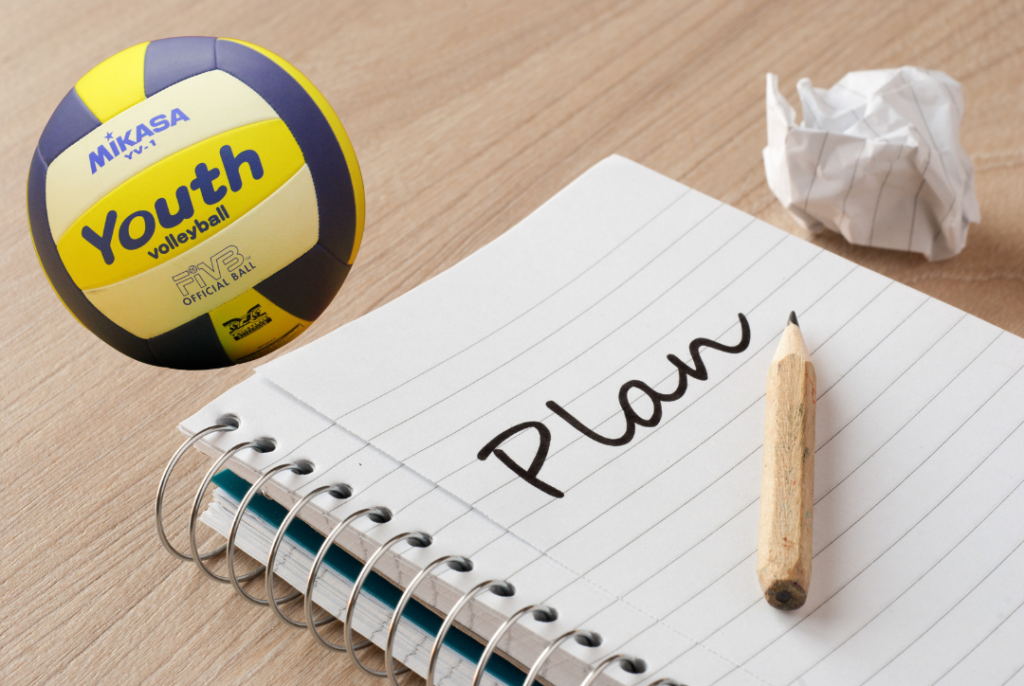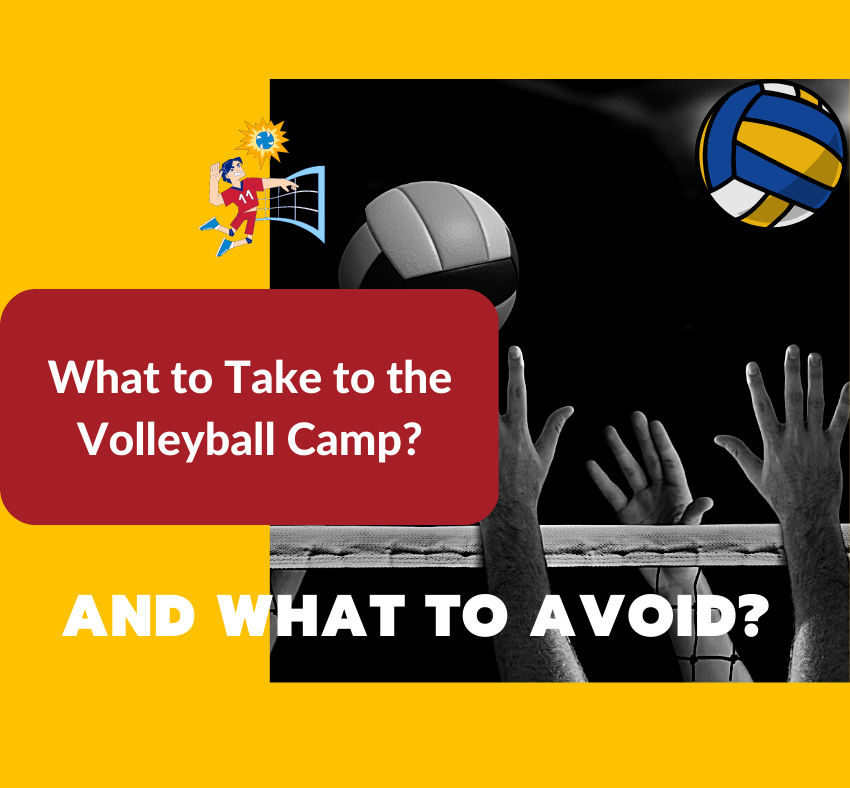How to Run a Volleyball Camp? (The Right Way)

There are two types of people who want to start a volleyball camp: One who are businessmen and want to do it to make money, and the second are volleyball lovers who want to start the camp to keep themselves engaged with the game while also making money in parallel. Whoever you are, this guide will walk you through all the steps needed to run a successful volleyball camp.
Running a successful volleyball camp requires careful planning of goals, designing camp programs, setting your budget right, strategy to fund the camp, capable staff, finding suitable equipment, ensuring players’ safety, marketing your camp properly, and putting the right execution strategy, among other things.
Here is the step by step guide to plan your volleyball camp the right way:
Planning the Volleyball Camp

Benjamin Franklin said,
“Failure to plan is planning to fail.”
This saying perfectly fits the planning of a volleyball camp as well.
The initial phase of starting a volleyball camp involves careful planning. This is the stage where you lay the foundation for your camp, and it’s crucial to get it right.
The first step in this process is to set clear goals and objectives for your camp. What do you hope to achieve with this camp? Are you looking to introduce the sport to beginners, or is your camp aimed at helping intermediate players advance their skills?
If your goal is to nurture young, budding players, your objectives might include teaching the basics of volleyball, promoting teamwork, and fostering a love for the sport. On the other hand, if you’re targeting experienced players, your objectives might be more focused on advanced techniques, strategic gameplay, and preparation for competitive events.
Volleyball camps mostly focus on beginners, so if you are uncertain about the target audience of your camp, you can assume that you will target the newbies who are just starting out the game.
Getting this step right is crucial for various reasons.
For instance, the age group and skill level of your participants will significantly influence the camp’s structure, including the type of drills, the level of instruction, and even the choice of equipment and coach.
Once you have defined your goals and identified your target audience, the next step is to decide on the types of camps you want to have.
Volleyball camps have varied lengths.
You will see camps that are a day long, have overnight stays, or even last for one or two weeks.
Your best bet would be to introduce all these programs at once and let the players choose their favorite program.
When designing the length and schedule, you must keep the physical demands of volleyball and other equipment in mind.
And keep this important tip in mind for longer camps.
While it’s crucial to provide plenty of time for instruction and practice, participants also need adequate rest periods to recover and prevent injuries.
A well-balanced schedule includes a mix of skill drills, scrimmage games, strategy sessions, and rest periods.
Also, consider including some off-court activities and innovative tactics to lure players into your volleyball camp. Such additions can make the camp more enjoyable and provide a well-rounded experience for the participants.
Doing Budgeting for the Camp

Budgeting is a crucial aspect of running a volleyball camp.
You can’t even think of starting the volleyball camp before sorting out the budget. This phase involves identifying all potential costs and ensuring you have sufficient funds to cover them.
A well-planned budget not only keeps your camp financially viable but also helps set a fair and affordable fee for participants.
The first step in budgeting is to list all the potential expenses. Here are some of the key costs involved in running a volleyball camp:
Staff Costs
This includes salaries or stipends for coaches and support staff. The number of staff you need will depend on the size of your camp.
A lower coach-to-player ratio often results in better instruction and a more successful camp, but it may increase the cost. So aim to start with fewer coaches and increase gradually.
Facility Rental
Unless you own a suitable venue, you’ll need to rent a facility. The cost can vary greatly depending on the location, size, and amenities of the venue.
Equipment
You’ll need to provide volleyball equipment, including balls, nets, and possibly training aids.
If you’re targeting beginners, you might also need to invest in lighter balls or lower nets.
There are some essential things that players bring to volleyball camps themselves, so you may not spend money here.
Insurance
It’s essential to have insurance coverage for your camp to protect against potential liabilities. The cost will depend on the size of your camp and the specifics of the policy.
Administrative Costs
These costs include marketing expenses, registration software, communication tools, and any other administrative costs that are needed to run the camp smoothly.
Always remember that there is always room to add more facilities in the administration process, but you can do it as your cap grows.
Food and Beverages
If you plan to provide meals or snacks, remember to include this in your budget.
Even if you’re not providing meals, consider supplying water or sports drinks, especially for longer sessions. While not all the camps do it, those which do attract more players usually do.
Bringing Money for Your Volleyball Camps
If you have already sorted out the funding issue, well and good, if not, here are some important things you can do:
Seeking Sponsorships
Local businesses or larger corporations might be willing to sponsor your camp, especially if they can benefit from the exposure.
In return for their sponsorship, you could offer to display their logo or other promotional material on your camp gadgets and interior or mention them in your promotions.
Arranging Fundraising Events
Organizing a fundraising event, such as a charity match, a fun run, or a bake sale, can help raise funds for your camp. This can also serve as a promotional event for your camp.
Getting Grants
Some organizations offer grants for sports programs. Research local and national opportunities and consider applying if your camp meets the criteria.
Staffing the Camp the Right Way
Staffing is the backbone of your camp. The success of your volleyball camp largely hinges on the quality and dedication of your staff.
A well-staffed camp provides a superior experience for participants, ensuring they learn, have fun, and stay safe.
Coaches
The most important members of your staffing team will be your coaches. They should be knowledgeable about volleyball, with a solid understanding of the game’s rules, techniques, and strategies.
Ideally, they should also have experience coaching, particularly with your target age group. Coaches will be responsible for teaching and guiding participants, leading drills and games, and ensuring a positive and productive environment.
But there is more staffing you will require in order to run a successful volleyball camp.
Support Staff
For instance, support staff plays a crucial role in the success of a volleyball camp.
This includes administrative staff to handle registration, communication, and other logistical tasks.
You might also need staff to manage equipment, prepare facilities, and oversee meals or snacks if you’re providing them.
Medical Staff
Depending on the size of your camp, you may also need medical staff. This could be a dedicated athletic trainer or a nurse who can handle minor injuries and illnesses and respond to any medical emergencies.
Even if you don’t have a dedicated medical professional on staff, ensure someone on your team is trained in first aid and CPR.
Volunteers
They are an invaluable resource for your camp. They can assist with a wide range of tasks, from setting up equipment to helping with administrative tasks.
Some volunteers also assist with coaching, particularly if they have volleyball experience.
However, they should always work under the supervision of your experienced staff to ensure consistent, high-quality instruction.
When recruiting staff and volunteers, look for individuals who are not only knowledgeable but also passionate about volleyball and working with young athletes.
They should be patient, enthusiastic, and committed to creating a positive and inclusive environment.
Securing Facilities and Equipment
Once you have figured out the staffing requirements, it’s time to secure facilities and equipment for your volleyball camp.
The facilities and equipment you secure for your volleyball camp play a significant role in the overall experience of the participants.
They not only facilitate the smooth running of the camp but also contribute to the safety and enjoyment of the players.
Facilities You’ll Need
The location of your camp is a crucial factor. It should be easily accessible to the participants, with good transport links if possible.
The venue should ideally have ample parking space for parents dropping off and picking up their children.
The primary facility you’ll need is a volleyball court or courts, depending on the size of your camp. The courts should be well-maintained, with clear markings and a safe playing surface. If you’re running an outdoor camp, consider the impact of the weather and have a backup plan for rainy days.
You’ll need other facilities to support the camp’s operations.
For example, you’ll need restrooms that should be clean and conveniently located. If your camp runs for a full day or includes intense training, you might also need a space for participants to rest and eat.
A first-aid station is another essential facility.
It should be stocked with basic first-aid supplies and be easily accessible in case of injuries. If possible, it’s beneficial to have a quiet, shaded area where participants can recover if they feel unwell.
Equipment
The basic equipment you’ll need includes volleyball nets, balls, and possibly training aids like cones or markers for drills.
The quantity will depend on the number of participants and the structure of your camp. As a rule of thumb, ensure you have enough equipment to run your activities smoothly without participants having to wait for their turn excessively.
The quality of the equipment is also important. Balls should be of a standard suitable for the skill level of your participants. In fact, having good quality volleyball will bring your camp into the good books of the participants.
Also, nets should be sturdy and set up securely. Any training aids should be safe and effective for their intended use.
Designing the Camp Program
While you may plan the basics of your camp program in the planning phase, now is the time to make detailed programs that you will promote to get players onboard.
Designing the camp program is a critical aspect of running a volleyball camp. A well-structured program can ensure that participants learn effectively, have fun, and stay engaged throughout the camp.
All the programs should be a balanced mix of drills, games, and rest periods.
Here is what I mean:
Drills
They are designed to sharpen the skill of the players. Drills should be designed to teach and practice the essential skills of volleyball, such as serving, passing, setting, hitting, blocking, and digging.
They must be age-appropriate and match the skill level of your participants. For newbies, focus on basic skills that are specifically designed for beginners.
Games
Games are an excellent way to apply the skills learned in a fun and competitive environment.
They give participants the chance to use the techniques they’ve practiced in drills in a more dynamic setting.
Games can range from small-sided games, which allow more touches of the ball for each player, to full-scale matches. Fun volleyball games are the perfect way to hook players to your camp.
Rest Periods
Remember to incorporate rest periods into your schedule. Volleyball is physically demanding, and adequate rest is essential to prevent fatigue and injury.
Rest periods also provide a chance for participants to hydrate and socialize, which can enhance their camp experience.
While these are the common things that you can add to your volleyball camp, there are innovative ways that will make your camp go viral.
Ensuring Safety of Players to Get the Best Results
Ensuring the safety of all participants is critically important while running a volleyball camp. A safe camp not only protects participants from injuries but also creates a positive environment where they can focus on learning and enjoying the game.
Safety Measures and Protocols
Implementing safety measures and protocols is the first step toward creating a safe camp environment. Here are some key measures to consider:
Warm-up and Cool-down Exercises
Every session should start with a proper warm-up to prepare the body for physical activity and end with a cool-down to help the body recover. This can significantly reduce the risk of injuries.
Hydration Breaks
Camp participants can quickly become dehydrated, especially in hot weather. Regular hydration breaks should be scheduled, and water should be readily available at all times.
Safe Use of Equipment
Participants should be taught how to use all equipment safely. This includes how to set up and take down the volleyball net and how to handle the balls correctly.
First Aid
A first aid kit should be available at all times, and at least one member of your staff should be trained in first aid and CPR.
In the event of an injury, prompt and appropriate first aid can prevent the injury from worsening.
Sun Protection
If your camp is outdoors, sun protection measures should be implemented. This could include scheduling breaks in shaded areas, encouraging the use of sunscreen, and possibly providing protective gear like hats or sunglasses. (But try to encourage players to bring their own sun protection).
Marketing and Registration of Your Volleyball Camp
Nobody will know about your volleyball camp if you are not marketing it well.
If there is one thing that differentiates popular and unpopular volleyball camps, it is their marketing and registration strategy.
Once you’ve planned your volleyball camp and set everything in place, the next step is to attract participants.
This is where marketing comes into play. At the same time, you need to have an efficient registration process to ensure a smooth experience for those interested in joining your camp.
Marketing Your Camp
Here are some strategies that will help you market your camp in a better fashion.
Social Media
Platforms like Facebook, Instagram, and Twitter can be powerful tools for promoting your camp. You can post updates about the camp, share photos or videos, and even run targeted ads.
Remember to engage with your audience by responding to comments and messages.
Local Schools and Sports Clubs
Reach out to local schools and sports clubs to spread the word about your camp. They can share the information with their students or members who might be interested in joining.
Website or Blog
If you have a website or blog, use it to promote your camp. You can provide detailed information about the camp, share updates, and even allow online registration.
Email Marketing
If you have a mailing list, use it to inform subscribers about your camp. If you don’t have a list, consider starting one. Email marketing can be a highly effective way to reach interested participants.
Registration Process
Once you market your camp enough, you want to make it as easy as possible for people to register. Here are some tips to ensure an efficient registration process:
- Open Online Registration
- Provide clear registration information
- Maintain timely communication with participants to increase conversion rate.
Execution and Management of the Camp
Now that you have done everything to bring the volleyball camp into the running position, this is the time to put your execution and management strategy in place.
The execution and management phase is where all your planning comes to fruition.
It involves running the day-to-day activities of the camp, dealing with any unexpected issues, and ensuring a positive and enriching experience for all participants.
Managing Day-to-Day Activities
The daily management of the camp involves overseeing the schedule of activities, ensuring everything runs on time and that all participants are engaged and learning.
Make a list of all the activities that you are doing in the camp, and have a printable checklist at your table that will help you manage things more efficiently.
A crucial part of this management is to ensure that your staff is clear on their roles and responsibilities each day.
Regular staff meetings can be helpful to discuss the plan for the day, address any issues, and ensure everyone is on the same page.
Dealing with Unexpected Issues
Despite the best planning, unexpected issues can arise. This could be anything from a participant falling ill, equipment breaking, or bad weather disrupting outdoor activities.
The key to dealing with unexpected issues is to stay flexible and have backup plans. For example, have a plan for indoor activities if outdoor play isn’t possible due to the weather.
If a participant falls ill, ensure you have a safe and comfortable place for them to rest until they can be picked up.
Ensuring a Positive Experience and Encouraging Feedback
The ultimate goal of your camp is to ensure a positive experience for all participants. This means creating an environment where they feel safe, welcomed, and excited to learn.
Regularly check in with participants to see how they’re doing and if they’re enjoying the camp. Encourage feedback and be open to making adjustments to improve their experience.
Remember to celebrate successes, no matter how small, and foster a sense of camaraderie among participants.
This can be done through team-building activities, group discussions, or simply by fostering a supportive and inclusive atmosphere.
Final Words
As a volleyball camp owner or a manager, you will have a lot of responsibility. You can also help players in setting the short term and long term volleyball goals that will help them down in their careers. Also, always rememebr that once you are proficient in volleyball camp, the next step is to upgrade the facility to volleyball club and build a club team that is hard to beat.

Ahmed is the founder of Ball and Net Sports, a platform where he writes about volleyball.
As a professional volleyball player who has participated in various national and international level volleyball competitions, he loves to teach other volleyball enthusiasts about the game.
He is now a professional volleyball coach who organizes volleyball camps and social events for talent hunting for top volleyball teams.
As a volleyball talent-hunting specialist, he loves to teach people how they can make their game better in the fast-paced volleyball environment where it is extremely difficult to get quality content free of cost.



